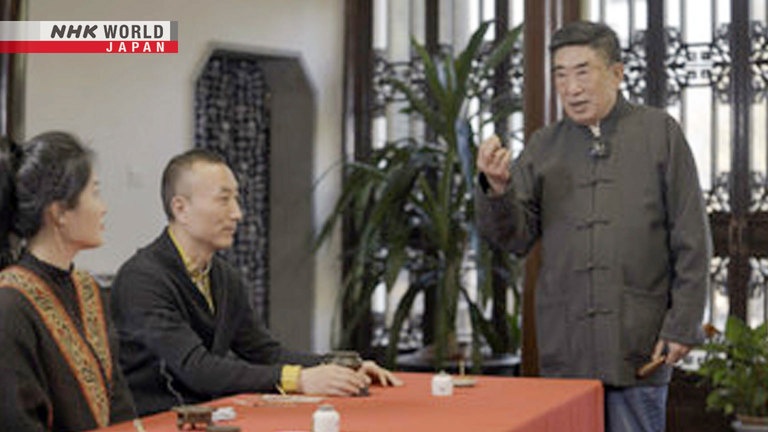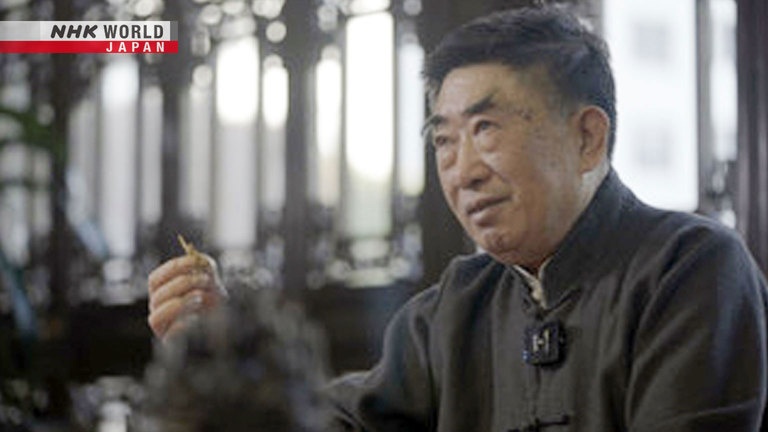The Language of Incense: Fu Jingliang / Modern Incense Culture Founder
Fu Jingliang, the 1st inheritor of Incense Culture, has been researching incense for over 30 years. Due to the pandemic, it drew the attention of Chinese.


Transcript
Direct Talk
Throughout China's history,
the spirits of plants have been
transformed into incense.
This is borneol,
a crystallized compound of a tropical plant.
It's believed to play a significant role in
the treatment and prevention of epidemics,
Fu Jingliang has given new life
to the culture of incense in China.
He's worked with incense
for more than 40 years.
My concept of "incense culture"
represented something new in China.
My incense culture is an integrated system.
It involves the history
and theory behind incense,
as well as aromatic herbs and medicines,
incense tools and sets,
and the blending of aromas.
So I think it's fair to give my concept
the name of "incense culture."
The pandemic brought incense
into the spotlight in China,
for both normal citizens
and medical professionals alike.
The Language of Incense
We take a look into the
mysterious culture of incense.
Dongcheng District, Beijing, China
The great poet Qu Yuan
revered incense as a mentor,
one who taught him values
and ethical principles.
He pondered whether
his deeds were right or good
by comparing them to incense.
As a leader of modern
incense culture in China,
Fu has taken on many new endeavors.
He's created a website,
published a book,
and even established a company
to promote the development of incense.
Those efforts have established a solid
foundation for the development and heritage
of incense culture.
Fu also hosts and attends incense lectures
and events all around China.
We can divide China's incense culture
into four stages.
The first stage is ancient times,
the period from 4,000 B.C. to 2,000 B.C.
The second stage,
which includes the Spring and Autumn Periods
as well as the Warring States Period,
is when the culture of incense
began to sprout.
The third stage includes the Han,
Tang, and Song dynasties.
It was a peak period of incense development.
But in the fourth stage,
the culture of incense faded.
His knowledge and experience
have helped him cultivate thousands of fans
and successors of incense culture.
Based on the historical traditions
of ancient Chinese,
who utilized incense in
almost every aspect of daily life.
Fu has dedicated himself to popularize
the lifestyle of incense in the modern era.
He has developed innovative burning incense,
incense accessories,
food and wine that make use of incense.
Perhaps most importantly,
he's developed incense "prescriptions"
believed to be good for health.
Besides the purported health benefits,
these incense prescriptions
also allow modern people
to relate to the experiences
of their ancestors.
Fu's passion for incense
is closely related to
his experiences in childhood,
as well as his family environment.
When I was about three or four years old,
I had to memorize a series of ancient books.
"Four Books and Five Classics,"
"Inner Canon of the Yellow Emperor,"
"Tao Te Ching," and more.
As a child, I didn't understand those books.
But I memorized them as I was told.
Incense was indispensable in the everyday
life of the elder generations in my family,
like my grandparents.
They always burnt incense
when they wanted to focus on something,
or were doing something very important.
I didn't understand why,
but because of their influence,
burning incense became
one of my habits as well.
I was naughty as a boy -
I'd steal incense and had lots of fun
burning, eating, and experimenting with it.
I caused lots of trouble.
Those childhood experiences
had a big influence on me.
But during the special period,
it all came to a halt.
For about 10 years,
I stopped dabbling in incense.
During those 10 years,
Fu finished school,
then tried his hand
at jade carving, archaeology,
and teaching calligraphy.
In the early 80s,
Fu was reading through ancient books in the
hopes of finding new direction for his life.
From those books he found one of the
crucial keys of Chinese culture: incense
and inspired him
to pursue the topic of incense.
But he couldn't have imagined
the challenges along the way.
I did encounter lots of difficulties
during this journey.
For example, I decided to visit
reclusive masters of incense,
to learn about the history
and heritage of incense,
then combine that knowledge with my memories
of the books I read in my childhood.
In addition, lots of incense ingredients
are difficult to find.
I didn't know where to find them.
So, I had to figure out
where to find good ingredients first,
and to understand how their
growth environment affects their quality.
It was also difficult to
physically gather those ingredients,
because of the potential injuries
and risks posed by wild animals,
insects, and potential accidents.
I've often encountered lots of adversity,
but I often found it interesting,
because I enjoy having fun,
and I love to explore new things.
And since I believed this journey
I had chosen was meaningful,
I just kept on going, without hesitation.
Over a span of nine years,
Fu traveled throughout
the Chinese countryside,
collecting and experimenting with
high-quality incense ingredients.
Finally, he was ready for the next step:
creating incense at the sacred Mount Tai.
I went to Mount Tai to verify
what I had learned from books
about the heritage and recipes of incense.
As incense can easily be affected
by the presence of other scents,
different environments
can affect the qualities,
sillage, and effects of incense.
The air deep in the mountains
is relatively pure.
Without interference from other scents,
I could relax and
focus on my work undisturbed.
During the process,
I repeatedly compared the incense I made
to the recipes and techniques
passed down in ancient books.
I wanted to find out
whether I was doing it right,
and what level I had managed to reach.
For example,
if I wanted to reproduce incense
from the Han Dynasty,
then what did I need to do?
Did I reproduce it successfully?
And what about incense
used in the Tang Dynasty?
What incense was used
in the studies or palaces
or even cure diseases of that time?
I need to test it out.
Over a period of three years,
Fu would spend up to
two consecutive months at a time
living deep in the mountains.
Despite living with just the bare minimum,
he found enjoyment
in the rugged lifestyle.
For each two-month stay,
I would bring 20 kilograms of food.
When I had eaten up all the food,
that told me two months' time had passed.
I felt I communicated with the ancients,
finding out the milestones of their lives.
During his time on Mount Tai,
Fu was able to recreate
2,600 blends of incense.
Which becomes the foundation of
modern Chinese incense culture.
In 2020,
incense sachets believed to protect against
the pandemic were in demand in China.
People are fond of incense, simply by nature.
Since the period when the "Inner Canon
of the Yellow Emperor" was written,
through practices in their works and lives,
the people of ancient China understood
the benefit of the aromatic plants,
for example,
detoxifying snake venom,
pest control,
modifying temperament,
improve physical wellness,
and even to prevent epidemics.
The most important discovery
was that some aromatic plants
could be added into sachets,
which would give off an aroma
as a result of the wearer's body heat.
Then those aromas would be
absorbed through the skin,
the nose or ears,
or the body's meridian network.
And these aromas would exert
certain physiological effects.
As modern technology evolves,
the chemical components of the herbs are
extracted, analyzed, and experimented with.
So we have the opportunity
to understand the mechanisms of incense.
For example,
those aromas can enter our bodies
through our respiratory tracts,
then help our nasal or
upper respiratory tract mucosae
to produce a certain antibody
called immunoglobulin A,
which can prevent bacteria
and viruses from surviving in our system.
Xu started her research on aromatherapy
after attending the Sanskrit Chant Concert,
which was held by Fu in 2016.
Over ten thousand people
attended the concert,
where hundreds of kilograms of incense
were burnt.
With the addition of stage lights
and Buddhist mantras,
the event was a feast for the senses.
Incense has its own language.
Different incense diffuses different aromas.
Blending incense is similar to
telling a story with musical notes.
My students asked me:
If incense has its own language,
then what would that language
sound like with music?
How does incense influence a person,
from their emotions and mental state,
to their physical body?
I hope to seek answers to these questions.
After 30 years spent working with incense,
Fu now views incense very differently
than he did in his childhood.
Different aromas exist within the incense
made by different students,
as everyone has their unique characteristics.
The heart's state of being,
the love and blessings,
the power of thought and intention,
they all go into the incense.
And for that reason,
I remind everyone to focus their attention,
quiet the mind,
and become one with the incense.
Only through this approach can the incense
transcend beyond the limits of the world,
guiding and assisting us to the essence
and spiritual energy of the universe.
This brings us closer and closer to wisdom.
His incense-making process involves
communication with the spirit of plants,
and the herbs reincarnates into the world
through Fu's masterful creation.
Continuing Saint YU's Path
like a Diligent Swallow.
Yu the Great was a king of
ancient China, a saint.
He dedicated his life
to the well-being of people.
And the swallow is regarded
as an auspicious bird in China.
Swallows are also considered
incarnations of Fuxi,
a hero in Chinese mythology.
I hope I can bring happiness
to others throughout my life,
just like a swallow who follows
in the footsteps of saints.
The incense culture of China,
rekindled by Fu,
allows people to commune with nature,
and helps them to enrich their inner worlds.
Perhaps incense will also serve
as a bridge into the future.
Continuing Saint YU's Path
like a Diligent Swallow.